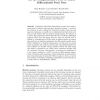Free Online Productivity Tools
i2Speak
i2Symbol
i2OCR
iTex2Img
iWeb2Print
iWeb2Shot
i2Type
iPdf2Split
iPdf2Merge
i2Bopomofo
i2Arabic
i2Style
i2Image
i2PDF
iLatex2Rtf
Sci2ools
FORMATS
2006
Springer
2006
Springer
On the Computational Power of Timed Differentiable Petri Nets
Abstract. Well-known hierarchies discriminate between the computational power of discrete time and space dynamical systems. A contrario the situation is more confused for dynamical systems when time and space are continuous. A possible way to discriminate between these models is to state whether they can simulate Turing machine. For instance, it is known that continuous systems described by an ordinary differential equation (ODE) have this power. However, since the involved ODE is defined by overlapping local ODEs inside an infinite number of regions, this result has no significant application for differentiable models whose ODE is defined by an explicit representation. In this work, we considerably strengthen this result by showing that Time Differentiable Petri Nets (TDPN) can simulate Turing machines. Indeed the ODE ruling this model is expressed by an explicit linear expression enlarged with the "minimum" operator. More precisely, we present two simulations of a two count...
| Added | 22 Aug 2010 |
| Updated | 22 Aug 2010 |
| Type | Conference |
| Year | 2006 |
| Where | FORMATS |
| Authors | Serge Haddad, Laura Recalde, Manuel Silva |
Comments (0)

